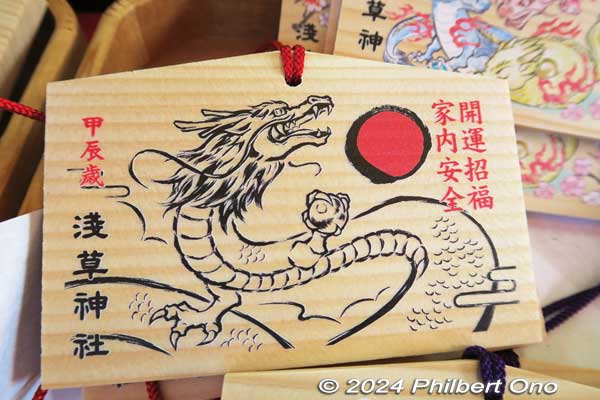
Wishing you the best in 2024, the Year of the Dragon.
My heart goes out to people in Ishikawa (especially Noto Peninsula) and Toyama Prefectures starting off the new year with a large earthquake, tsunami warnings, aftershocks, and substantial property damage. The second day of the new year was also shocking with the runway accident at Haneda Airport. Prayers and condolences to everyone affected. Hoping for a speedy recovery. 🙏
Japan has a great variety of dragons. Here’s a collection of some of them from Hokkaido to Okinawa spreading good luck and good fortune to all.🐉🐲

This year is actually the Year of the Wood Dragon which comes only once every 60 years (last time was in 1964). According to Chinese beliefs, the Year of the Dragon rotates between five types of dragons: gold dragons, earth dragons, fire dragons, water dragons, and wood dragons. So each type occurs only once per 60 years. Each type signifies a different personality and fortune (if you believe in such things).
Photo shows a wood carving of a dragon on a corner of Shibamata Taishakuten Temple (柴又帝釈天) in Shibamata, Katsushika-ku, Tokyo. This temple is famous for many intricate woodcarvings on the exterior and for the beloved Tora-san movie series.
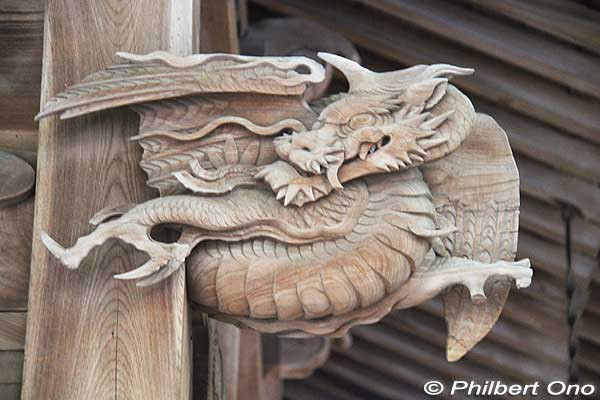
Another wood dragon at Tanashi Shrine in Nishi Tokyo.

One of Tokyo’s most famous Buddhist temples, Sensoji Temple in Asakusa was founded when two fishermen brothers found a golden Kannon statue in Sumida River. Three days later, according to legend, a golden dragon descended from heaven and danced. Hence, the temple and shrine’s association with the dragon.
Their wash basin here has dragons spewing water to purify yourself.
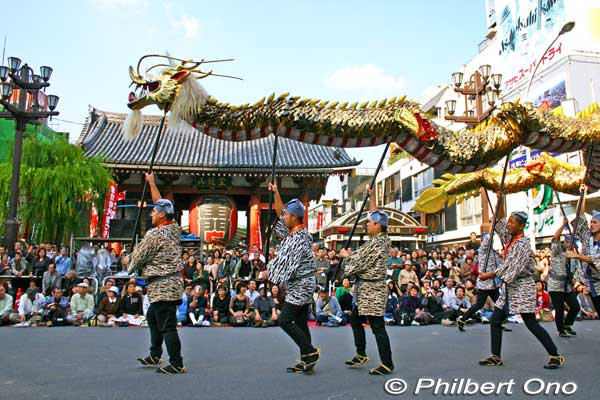
Sensoji Temple also has a golden dragon which they perform at major Asakusa festivals. The dragon is 15 meters long, weighing about 80 kg. It has a bamboo frame, covered with cloth. Eight men use poles to manipulate the golden dragon.
The golden dragon legend gave Sensoji’s mountain name of “Kinryu-zan” (金龍山) meaning Golden Dragon Mountain. In the old days, Buddhist temples were also named after the mountain they were located on. Eventually, even when a temple was not on any mountain, they still adopted a mountain name. So most Buddhist temples have two names.

At the Sapporo Snow Festival in Hokkaido, an award-winning and exquisite dragon ice sculpture in Susukino some years ago.
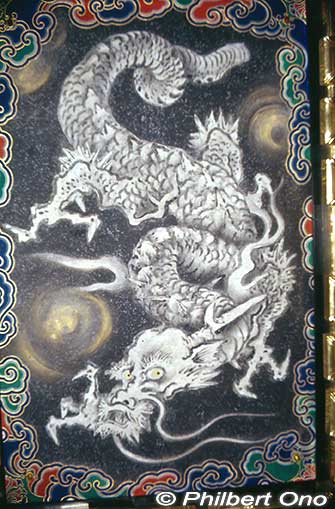
At the famous Nikko Toshogu Shrine (World Heritage Site) in Tochigi Prefecture, there’s this dragon painting on the ceiling that roars (more like a yelp) when you clap below it. It’s actually works like a clever echo.

At the Harry Potter Tokyo studio, a Hungarian Horntail dragon greets you high above at the entrance. It’s native to Hungary and depicted as the most frightening and vicious of dragons with black scales and spiked tail.
It appears in “Harry Potter and the Goblet of Fire” when Harry had to steal a dragon egg from the dragon during the Triwizard Tournament. It almost killed Harry. The film credits at the end says, “No Dragons were harmed in the making of this movie”.🤣
The image of dragons is way different in Asia where it’s an auspicious creature and symbol of good fortune. Dragons in East Asia are typically wingless and not fire-breathing.

Chinese dragon sculpture on the gate at Kwan Tai Temple (Kuan Ti Miao 関帝廟) in Yokohama’s Chinatown. Notice no wings.
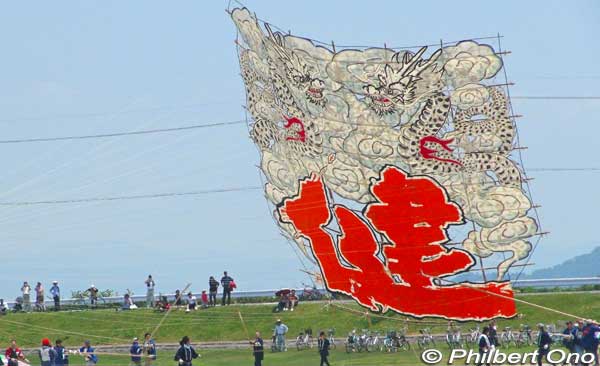
This giant kite at the Higashi-Omi Giant Kite Festival (東近江大凧まつり) in Shiga Prefecture some years ago had a design with twin dragons and a vermillion kanji character (健). This design is actually a play on words: The twin dragons can be pronounced “shin-shin” using the kanji for dragon (辰辰).
It’s a homonym for “mind and body” also pronounced “shin-shin” (心身). The kanji character reads sukoyaka (健やか), meaning good health. So the kite wishes for the “good health of your mind and body.” Valid message for New Year’s too.
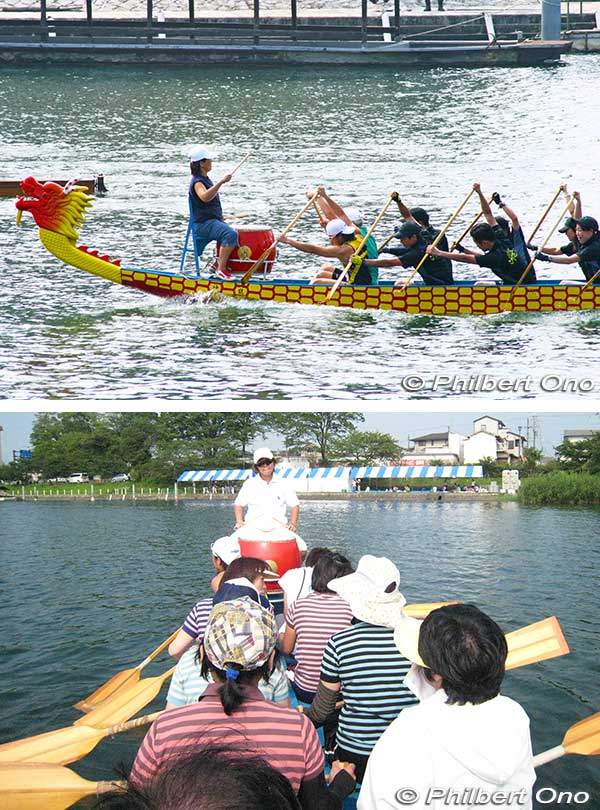
Rowing on a dragon boat on Lake Biwa as a side show during a regatta. Since there are so many paddlers, a taiko drummer gave us the beat to row in sync. Dragon boat races have been around for 2,000 years, even before the first Olympics in Greece. Since dragons in Asia are associated with water, having dragon boats is natural.
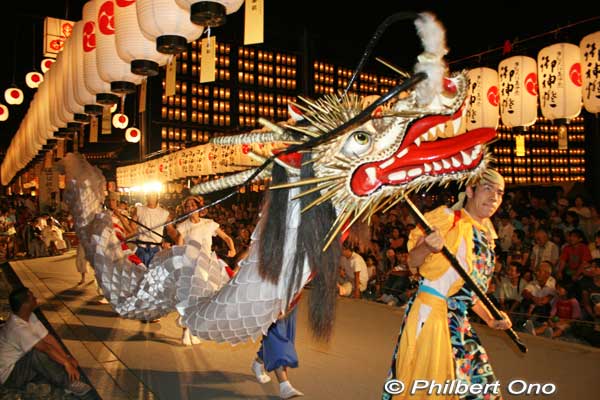
Dragon dance at Taga Taisha Lantern Festival in August in Taga, Shiga Prefecture.

At Kiyomizu-dera Temple, Kyoto, Blue Dragon dance (Seiryu-e 青龍会). Performed on two days in March, April, and Sept. The Blue Dragon is a manifestation of the Thousand-Hand Kannon Goddess of Mercy worshipped by the temple. Unusual color for a dragon.

In northern Kyoto facing the Sea of Japan, Amanohashidate (Bridge to Heaven) is one of Japan’s famous Scenic Trio. When you go there, you will notice many people bending over to look at it upside down. It’s supposed to look like a flying dragon (hiryu 飛竜) when viewed upside down, especially from this southern end. I agree. The dragon’s head is in the front and the slim, wavy tail in the back. Amanohashidate is actually a sandbar and you can cross it on foot or rented bicycle.

In Uji, Kyoto, Manpukuji Temple (萬福寺) has this path modeled after dragon scales. Amazing imagination. Manpukuji is the headquarters of a Chinese Zen sect called Obaku-shu. It’s one of the Big Three Zen sects in Japan (besides Soto and Rinzai). The temple has a restaurant serving Chinese-style religious vegetarian cuisine called fucha-ryori. Absolutely delicious and healthy too.

This dancer is performing an Imperial court dance dating back to the 8th century. He depicts Chinese warrior Ranryo-o, the Prince of Lanling (Gao Changgong), a victorious 6th century general (舞樂蘭陵王). To hide his gentle-looking face, Ranryo-o wore a fierce dragon head mask in battle.
This dance was performed during the Saio Princess Matsuri festival in Meiwa, Mie Prefecture.

Near JR Tottori Station in Tottori Prefecture, street bench with a dragon log. It’s not at a bus stop or anything, so I wondered why it was there. Probably just street art.

In Beppu, Oita Prefecture in Kyushu, the famous circuit of hot spring hells include this hot spring named “Golden Dragon Hell” (金壟地獄).

Dragon bridge at Tomari Port, Naha’s main port in Okinawa where you can take a boat to nearby islands like Tokashiki. Bodies of water are the domain of the dragon.


In Naha, Okinawa, near Naminoue Beach is a pair of huge Ryuchu dragon pillars (龍柱) on Wakasa-naka-dori road. One has an open mouth, and other with a closed mouth. The Ryuchu dragon pillars are Naha-Fuzhou Friendship City Exchange Monuments.

In Naha, Okinawa, the two stone dragon pillars (dairyuchu 大龍柱) in front of Shuri Castle survived the catastrophic fire in Oct. 2019. However, they had cracks, so they were being repaired when I visited in 2020.
Meanwhile, the reconstruction of Shuri Castle is progressing quite well. They just finished building the castle’s framework. We should see a brand new Shuri Castle in a few years.
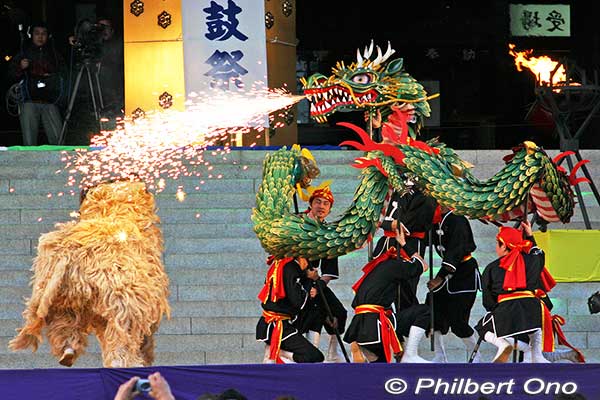
Okinawan taiko drum troupe perform a dragon dance and shishimai lion dance in front of Narita-san Shinshoji Temple during the Narita Taiko Festival in April in Narita, Chiba. This one even breathes fire. Dragons are often depicted dancing to bring rain since dragons are associated with water. Lots of dragons in Okinawa where there’s lots of water.
Hope you enjoyed my dragons. Interesting that although fictional/mythical, dragons have existed in both the Far East and the West. Nobody knows where or how it originated in the world. Did it come from crocodiles? Sea horses? Lizards like the Komodo dragon? Nobody knows. Stay safe and healthy in 2024.🎍